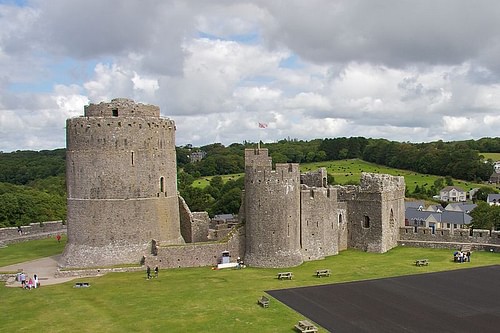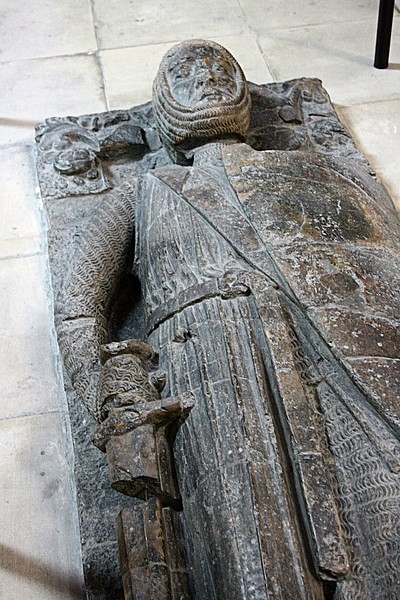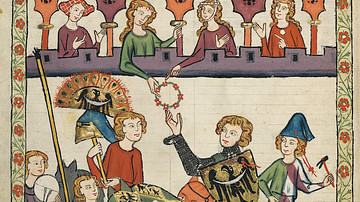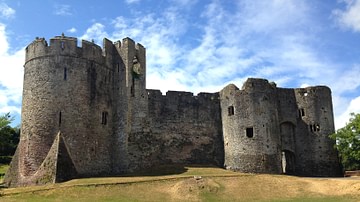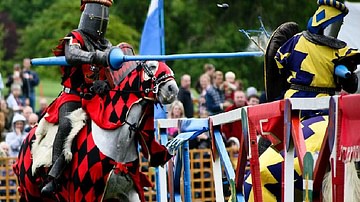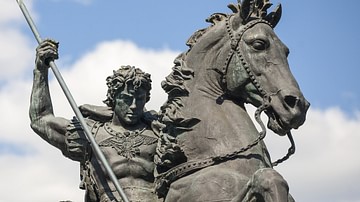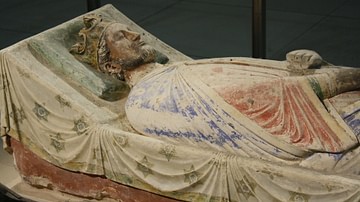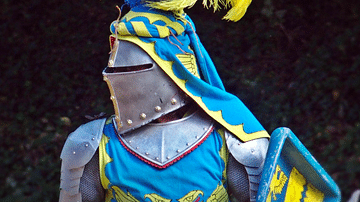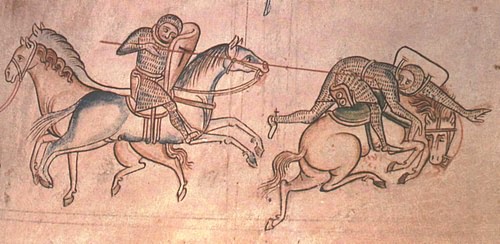
The Englishman Sir William Marshal (c. 1146-1219 CE, aka William the Marshal), Earl of Pembroke, is one of the most celebrated knights of the Middle Ages. Renowned for his fighting skills, he remained undefeated in tournaments, spared the life of Richard I of England (r. 1189-1199 CE) in battle, and rose to become Marshal and then Protector of the Kingdom - king in all but name. Shortly after William's death, Stephen Langton, the Archbishop of Canterbury, described him as 'the greatest knight that ever lived' and his deeds and titles are such that the claim still seems justified today.
Youth
William Marshal was born c. 1146 CE and he experienced his very first misadventure aged just six when his father's castle at Newbury was attacked by an army of King Stephen's (r. 1135-1154 CE). John Marshal was forced to give up his young son William as a hostage while the attack was suspended in order for the terms of a surrender to be settled. However, John had other ideas and used the respite to restock his castle with provisions. This seemed a risky strategy considering his son was in the hands of his enemies but when threatened with the execution of William his father glibly replied 'I have a hammer and an anvil on which I can forge better sons than he!' (Phillips, 104). Fortunately for William, he escaped both death and his family when Stephen decided not to end his young life by hanging him as threatened (or catapulted over the castle walls as some had proposed) and instead made him a royal ward. This was a fortuitous outcome for everybody since William, being the younger of several brothers, had no chance of inheriting the estates of his father and had to make his own way in the world anyway. It was not a bad start, after all.
Having got over perhaps his greatest challenge, William embarked on the usual career path of a young nobleman. His mother's cousin was William de Tancarville, the Chamberlain of Normandy (at that time under the English crown) and it was at his court that he began his education and training as a squire with the eventual aim of becoming a knight. William here gained a reputation as a big eater and acquired the nickname of gaste-viande (glutton). Still, he must have impressed his tutors and sponsor in other ways for William was knighted in 1166 CE aged just 20 and he was then sent on his way to make his own fortune. One of the great medieval chivalric careers was about to begin - after an initial hiccup, that is.
Early Career
William the young knight was immediately called into action in 1166 CE when he was dispatched to fight in the war between Henry II of England (r. 1154-1189 CE) and the counts of Boulogne, Flanders and Ponthieu. Stationed at the castle of Neufchâtel-en-Bray in Normandy, William showed promise and bravery but after a skirmish where he lost his horse, he was warned by William de Tancarville not to be stupidly rash in warfare. As a punishment, the knight was not given a replacement horse and he found himself in something of a predicament as he had no funds to acquire one himself. Selling his clothes to buy a new horse, William looked for better fortune in that other alternative to glory besides warfare: the medieval tournament.
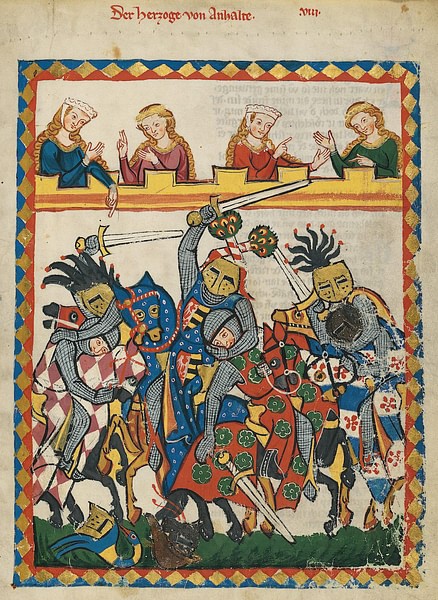
Entering the tournament of Le Mans in France in 1167 CE, the young knight exceeded all expectations in the mêlée, a sort of mock cavalry battle where knights had to capture each other for a ransom agreed on before the match. William did so well he now owned four and a half horses (presumably he captured a similarly cash-strapped opponent unable to pay the whole ransom or perhaps it was a joint capture). William then carried on touring, and winning, at tournaments over the next year, usually in a profitable partnership with the Flemish knight, Roger de Gaugi. There were occasional setbacks such as when William's helmet was so bashed by opposing knights he needed a blacksmith to remove it but, capturing an impressive 103 knights in all, Marshal racked up a fortune in ransom money and cash prizes. The legend of William Marshal was up and running and, over the next 16 years of competition, he would remain undefeated. On his deathbed years later, William claimed to have personally captured 500 knights in his tournament career.
Appointment at Court
In 1168 CE William was back in real warfare but it went as badly as his first experience. Fighting in Poitou in western France with the army of his uncle the Earl of Salisbury, William was injured and captured by the forces of Guy de Lusignan. Fortunately, the habit of asking for ransoms was not exclusive to tournaments and William could be freed at the right price. Eleanor of Aquitaine, consort of Henry II, came up with the cash and William was freed. Recognising William as a great talent not to be wasted, Eleanor employed the knight as tutor-in-arms to her son Henry the Young King, then aged 15.
In between his court duties, William continued where he left off at tournaments and carried on winning vast sums of money. He was now rich enough to employ his own entourage of knights. Then, in 1182 CE, the wheel of fortune turned again, although it was William who nudged it. Accused of conducting an affair with Henry the Young King's wife, Margaret of France or, at the very least, committing some sort of offence to the royal family, the famous knight was banned from the court.
William's indiscretions may have been only gossip promoted by his enemies for he returned to court the following year and he and Henry were reconciled. Tragically, Henry then died of dysentery in June 1183 CE shortly after he had promised himself to go crusading and recapture Jerusalem from the Arabs. Instead, as legend would have it, on his deathbed Henry made William promise that he would take up the cause for Christendom in his place and he even gave the knight his cloak to take to Jerusalem. William did travel to the Holy Lands it seems but his exploits there are a blank in the pages of history and the story only resumes two years later with his return to England.
Richard I & Regency
By 1186 CE William was back at court from his travels and serving King Henry II again, notably in the campaigns of 1188-9 CE against Philip II of France (r. 1180-1223 CE), who had allied himself to the English king's two rebellious sons, John and Richard (the future Richard I Lionheart). In one battle or its aftermath, William came face to face with Richard and, when the prince was at his mercy, he spared his life, killing only his horse instead. The great knight was now adding chivalry (if not a love of animals) to his already formidable martial reputation.
When Henry II died in 1189 CE Richard became king and he did not forget William's generosity. As promised by the old monarch, the knight was first given a bride, the 17-year old Isabel de Clare, daughter of the immensely rich 2nd Earl of Pembroke and, as she was the heiress, it gave William prestige, wealth and castles. Amongst the castles were Pembroke and Chepstow, both in Wales. William is credited with converting the former from a wooden to an imposing stone structure and he improved the latter by adding a massive keep and hall.
William was now an indispensable member of Richard's court and while the king was off on the Third Crusade (1189-1192 CE), Marshal served on the council of regency. He was subsequently made Marshal of England. When King John of England (r. 1199-1216 CE) took over the throne following his brother Richard's death in 1199 CE, William continued in high office. When the king's unpopular reign led to a barons' rebellion, William, although loyal to the king, supported the barons in principle and became one of the creators and signatories of the Magna Carta in 1215 CE, a charter which curbed the powers of the monarch and upon which a constitution was based. Under the new king Henry III of England (1216-1272 CE), who was still a child, William was made the Protector of the Kingdom - in effect, regent of England.
Death & Legacy
Having served four English monarchs and risen to the very top of the kingdom, the great knight's time was nearly up. There was one last hurrah at the battle of Lincoln in 1217 CE when, aged 70, he led the English army and won against the still-disgruntled English barons and their French ally, the future King Louis VIII of France (r. 1223-1226 CE). Just before the battle and leading his army in person, William gave a rousing speech to his frontline troops, declaring that the enemy had so positioned their forces that he would win the day because he could attack with all his army at a single section of the opposition; and so it turned out.
William died two years later on 14th May 1219 CE and, loyal to those around him, as ever, he refused to permit the sale of his robes and furs to pay for alms, preferring instead they be given to his household knights. Just as William had promised himself when in the Holy Lands years before, he was invested as a Knight Templar and interred in Temple Church in London where his effigy still rests.
Stephen Langton, the Archbishop of Canterbury (1207-1228 CE) described Marshal as 'the greatest knight that ever lived'. The legendary knight's deeds, lengthy roll of honours, titles and public offices, and his unbeaten record at tournaments were all cemented in the public memory by the 19,000-line biographical poem L'Histoire du Guillaume le Maréchal, written between 1225 and 1229 CE by his son William Marshal II and the great man's former squire and executor John D'Earley. A rare medieval biography of a person, not a monarch, it provides an invaluable insight into politics, social affairs and the life of a knight in the Middle Ages.
